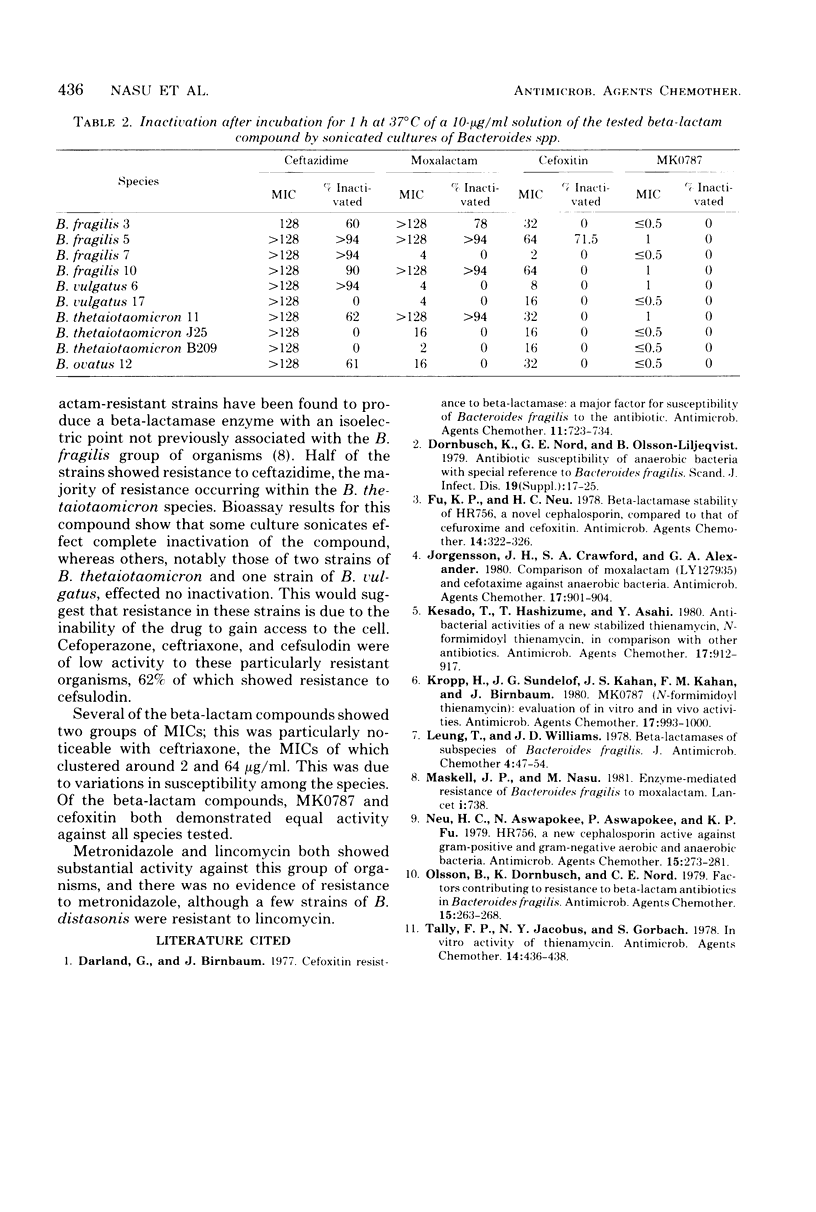Abstract
The susceptibilities of 82 strains of the Bacteroides fragilis group to eight beta-lactam compounds, lincomycin, and metronidazole were determined by using an agar dilution technique. MK0787 (N-formimidoyl thienamycin) was the most active compound, inhibiting all strains at a concentration of 1 microgram/ml. Metronidazole was the only other drug of similar activity. Of the beta-lactam compounds, cefoxitin and MK0787 showed uniform activity against all species, whereas most other compounds were relatively less active against Bacteroides distasonis and Bacteroides thetaiotaomicron than against B. fragilis and Bacteroides vulgatus. Using a well diffusion technique, we determined the relative stability of each beta-lactam compound to sonicated cultures of selected resistant strains. Whereas MK0787 was completely stable to inactivation--and with one exception, cefoxitin was also--ceftriaxone, cefotaxime, cephaloridine, and cefoperazone always showed some inactivation, often quite substantial. Moxalactam and ceftazidime were completely stable to some of the enzyme preparations.
Full text
PDF



Selected References
These references are in PubMed. This may not be the complete list of references from this article.
- Darland G., Birnbaum J. Cefoxitin resistance to beta-lactamase: a major factor for susceptibility of bacteroides fragilis to the antibiotic. Antimicrob Agents Chemother. 1977 Apr;11(4):725–734. doi: 10.1128/aac.11.4.725. [DOI] [PMC free article] [PubMed] [Google Scholar]
- Dornbusch K., Nord C. E., Olsson-Liljeqvist B. Antibiotic susceptibility of anaerobic bacteria with special reference to Bacteroides fragilis. Scand J Infect Dis Suppl. 1979;(19):17–25. [PubMed] [Google Scholar]
- Fu K. P., Neu H. C. beta-lactamase stability of HR 756, a novel cephalosporin, compared to that of cefuroxime and cefoxitin. Antimicrob Agents Chemother. 1978 Sep;14(3):322–326. doi: 10.1128/aac.14.3.322. [DOI] [PMC free article] [PubMed] [Google Scholar]
- Jorgensen J. H., Crawford S. A., Alexander G. A. Comparison of moxalactam (LY127935) and cefotaxime against anaerobic bacteria. Antimicrob Agents Chemother. 1980 May;17(5):901–904. doi: 10.1128/aac.17.5.901. [DOI] [PMC free article] [PubMed] [Google Scholar]
- Kesado T., Hashizume T., Asahi Y. Antibacterial activities of a new stabilized thienamycin, N-formimidoyl thienamycin, in comparison with other antibiotics. Antimicrob Agents Chemother. 1980 Jun;17(6):912–917. doi: 10.1128/aac.17.6.912. [DOI] [PMC free article] [PubMed] [Google Scholar]
- Kropp H., Sundelof J. G., Kahan J. S., Kahan F. M., Birnbaum J. MK0787 (N-formimidoyl thienamycin): evaluation of in vitro and in vivo activities. Antimicrob Agents Chemother. 1980 Jun;17(6):993–1000. doi: 10.1128/aac.17.6.993. [DOI] [PMC free article] [PubMed] [Google Scholar]
- Leung T., Williams J. D. beta-Lactamases of subspecies of Bacteroides fragilis. J Antimicrob Chemother. 1978 Jul;4(B):47–54. doi: 10.1093/jac/4.suppl_b.47. [DOI] [PubMed] [Google Scholar]
- Neu H. C., Aswapokee N., Aswapokee P., Fu K. P. HR 756, a new cephalosporin active against gram-positive and gram-negative aerobic and anaerobic bacteria. Antimicrob Agents Chemother. 1979 Feb;15(2):273–281. doi: 10.1128/aac.15.2.273. [DOI] [PMC free article] [PubMed] [Google Scholar]
- Olsson B., Dornbusch K., Nord C. E. Factors contributing to resistance to beta-lactam antibiotics in Bacteroides fragilis. Antimicrob Agents Chemother. 1979 Feb;15(2):263–268. doi: 10.1128/aac.15.2.263. [DOI] [PMC free article] [PubMed] [Google Scholar]
- Tally F. P., Jacobus N. V., Gorbach S. L. In vitro activity of thienamycin. Antimicrob Agents Chemother. 1978 Sep;14(3):436–438. doi: 10.1128/aac.14.3.436. [DOI] [PMC free article] [PubMed] [Google Scholar]


